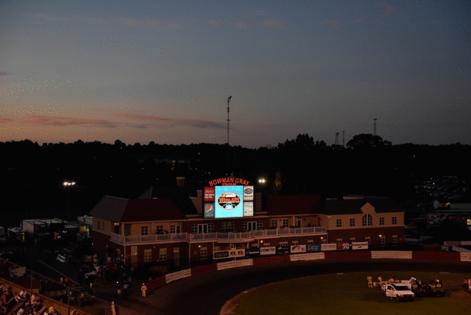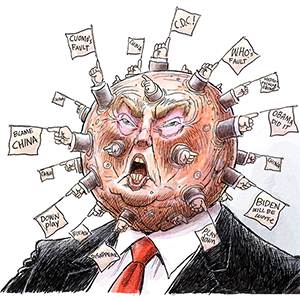As NASCAR returns to an NC track of yesteryear, there's a 'Cinderella story' to tell
Published in Auto Racing
CONCORD, N.C. — Thirty years ago, Tim Brown was a 20-something kid doing a little bit of everything for Cale Yarborough’s race team. He built motors. Installed car bodies. Hung suspensions. He was a short-track racer with big NASCAR dreams — and when he wasn’t working on other people’s cars, he was busy refurbishing his own and winning at short tracks all across the southeast, including in his home state of North Carolina.
Today, he’s in the middle of a “whirlwind.”
A “Cinderella story,” he aptly calls it.
One that culminates in the 2025 NASCAR Cup Series season-opener at the racetrack that he might as well call home.
The NASCAR Cup Series is returning to its roots when it hosts The Clash at Bowman Gray Stadium in Winston-Salem on Sunday (8 p.m., Fox). And with its return to an N.C. racetrack of yesteryear, the series will also witness Brown — the Yadkinville native and Rick Ware Racing employee and winningest driver in Bowman Gray Stadium history — make his first Cup Series start.
“I’ve called it a whirlwind, but it’s been really good,” Brown told The Charlotte Observer on Monday morning when asked what the last month has been like since the announcement. He was splicing in some time after his morning duties at the RWR shop were complete and before he moved onto his next media outing — an appearance on the The Dale Jr. Download.
“And the car is freaking amazing,” he continued. “So I’m super excited, man.”
Brown’s path to all-time winningest driver at Bowman Gray
To understand how this all came together, consider the separate paths of NASCAR and Brown — and how Bowman Gray looms large in each of them.
First, Brown:
The 53-year-old car builder and mechanic and driver first got into racing when he was a boy thanks to his grandfather, Eb Clifton, who owned a race shop in Yadkinville. Brown’s father wasn’t in the picture, so Clifton, in many ways, raised Tim and his brother, Ben. The grandfather took Tim and Ben to racetracks all across North Carolina and beyond.
When Tim graduated from Starmount High School, he wanted to be a racer. But he didn’t come from or have any money, so instead he leveraged the connections his grandfather had to work on Yarborough’s Cup team. That was his first job in racing. He’d work out of the race shop, do some traveling with the team, “and then I’d come back and race my car” — which was a Modified, something he afforded on his own money.
Wins, slowly and then pretty much all at once, began piling up. And nowhere was he more successful through the weekly features than at Bowman Gray Stadium — the quarter-mile oval and one of the oldest racetracks in North Carolina that hadn’t seen a Cup race since 1971 but that was thriving nonetheless.
He has favorite wins at Bowman Gray, certainly. His first one, in the early 90s, ranks up there. His 70th does, too, which gave him the most wins among drivers in the Modified Division at the racetrack. His favorite, he said, is the first one his whole family — his wife, Megan, and his son, Cam (8), and his daughter, Marley (3) — saw him win.
The one that gets remembered most is his 100th win at the Winston-Salem track — because that’s the one he passed Jimmy Johnson as the all-time winningest driver across all racing series at the stadium. Brown now has 101 victories and 12 track championships to his name to go along with 146 poles at the track.
In a few days, he’ll be able to live out a longtime dream when he makes his NASCAR Cup debut. He’s driven at a NASCAR national series race before, in a 2009 Truck Series race, but never at a Cup level — the level he admitted with a laugh Monday he wanted to race at when he was young.
“I wanted to be a Cup driver, that’s what my aspiration was,” Brown said. “And I thought, ‘Man, if I go to the stadium and run good, and win races, then Richard Childress or Rick Hendrick or somebody will call me, and I’ll get to drive a truck or Xfinity car or Cup car for them. The phone calls came, but they came with a ‘Hey man, how much money can you bring?’ Well, I didn’t have any money. It was all I could do to get to the racetrack to race my car.
“And once I turned 27, 28 years old, I realized that all the phone calls ceased when you didn’t have several million dollars to bring to the table. So at that point, I was like, ‘You know what? As long as I can still be competitive and win races and win championships, I’ll be content with that.”
And that’s what he’s done.
His story, in many ways, is not all that different than other short-track legends who didn’t get their shots at a full-time NASCAR national series because they didn’t have sponsorship money attached to them, or other extenuating circumstances. Take that of Bubba Pollard, one of the greatest short-track pavement racers of all-time, for instance.
“I sat in the stands and watched my grandpa’s cars race, and honestly, my grandpa’s cars didn’t have success,” Brown said. “I mean, they won a few races, but they didn’t win a bunch. And when I sat up there as a little kid, I just wanted to do it. I never dreamed I’d win a race, much less be the winningest driver in the place’s history.”
How NASCAR landed on Bowman Gray Stadium
The other half of that question — how did the Cup Series land at Bowman Gray? — can be answered by a simple look at a trend.
The last Cup race at Bowman Gray Stadium was in 1971, the same year Brown was born. It left in the earliest years of NASCAR’s expansion from sanctioned moonshiners competing to the biggest series in American motorsport. In the next three decades, though, the sport rose in popularity, and NASCAR officials tried to seize the moment — expanding out west and up north in search for bigger markets as stars like Dale Earnhardt and later Jeff Gordon made the sport a national one.
In the past five years, though, NASCAR has found success returning to some of the tracks that had been abandoned in the mid-90s in the early 2000s. North Wilkesboro Speedway in the foothills of North Carolina returned to the Cup Series schedule in 2023 and has been a sellout hit in both years it has hosted the NASCAR All-Star Race. Rockingham Speedway, another North Carolina track, is set to make its NASCAR return in 2025. The return to Bowman Gray falls in line with this trend — The Clash at BG was announced as a sellout in November.
And once the announcement was made, team owner Rick Ware said he had an idea to honor Brown, a car builder for RWR, almost immediately.
“When they started talking about it, immediately me and Tim started scratching our head and the thought process was, ‘Hey, let’s go see the feasibility of it,’ ” Ware said. “It was gonna depend a lot on whether or not we were running — was it gonna be a third entry as an open or was it gonna be the second car as an open? There are a lot of different scenarios, but we were pretty adamant that we were gonna do all that we could do to take him there.”
Brown appreciated the persistence from his owner and the return to Bowman Gray Stadium. The Clash, the past three years, has been at The Coliseum in Los Angeles — initially a big hit that lost its luster by its third year running there.
Bowman Gray certainly looks a bit different. The Cup Series’ presence — like installing the SAFER barrier, putting in other safety enhancements, the fresh paint — does that. “It doesn’t even look like the same racetrack,” Brown said. He went on to say that “it’s amazing how great that place looks” and that “it’s not like they just came in and slapped some paint on there, they’ve actually done some really nice renovating to the place.”
What else is NASCAR’s presence doing?
For Brown, this weekend, it does more than that 20-something kid could’ve dreamed of.
©2025 The Charlotte Observer. Visit charlotteobserver.com. Distributed by Tribune Content Agency, LLC.







Comments